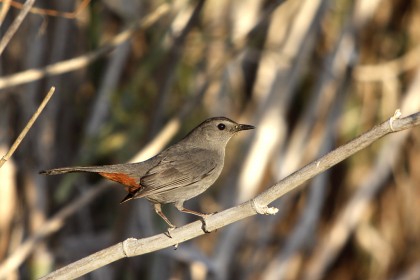
Cape May is a world-famous migration hotspot, especially during autumn cold fronts when heavy northwest winds cause birds to drift coast-ward.
The Cape May peninsula becomes a place where birds, hesitant to cross the open water of the Delaware Bay, become bottled up. During these times, Cape May can host spectacular numbers and varieties of birds.
One curious aspect of this phenomenon is that the majority of these bottled-up birds are juveniles – birds making their first migration. It is illustrated most vividly in hawks, where 95 percent of the birds observed in Cape May are young birds. The juvenile bias is apparent in songbirds as well, although not as well documented.
A remarkable study that was carried out here in New Jersey has helped clear up the question of why there is a higher proportion of juveniles in Cape May. Princeton researchers caught and attached radio transmitters to a sample of juvenile and adult catbirds during fall migration in central New Jersey. The birds were released and tracked from an airplane to see how they handled the troublesome coastal geography of Cape May as they continued their journey south.
The researchers found that juvenile birds headed due south, taking them straight to Cape May to face an open-water bay crossing and a harrowing density of equally wayward and hungry juvenile song-bird eating hawks. The adults , on the other hand, skirted the Cape May situation and adjusted their southward heading westward to go around the Delaware Bay and avoid the peninsula altogether.
A) Tracks and (B) circular diagram of orientation of adult and juvenile catbirds captured in New Jersey. Blue, adults; yellow, juveniles. Arrows in B and all subsequent circular diagrams represent mean bearing and vector length (with the edge of the circle asr=1).
What this shows is that young birds have an innate sense of direction that takes them south – but with experience, they can adjust their heading using other cues during subsequent journeys.
What might these other cues be? To understand how adult birds were making the adjustment to avoid Cape May, the Princeton study investigated magnetic and olfactory cues. (There is evidence that birds use these senses, among others, to navigate.)
For the magnetic question, birds were subjected to a strong magnetic pulse that disrupted their ability to sense the earth’s magnetic fields. To address the olfactory question, some birds had zinc suphate swabbed on their nostrils, temporarily blocking their sense of smell.
A set of juvenile and adult catbirds lacking their magnetic sense and another set that lacked their sense of smell again set forth southbound from Princeton.
This time something amazing happened: all of the birds, young and old alike, headed straight to Cape May. The adults somehow lost their ability to skirt the bay when they lost their sense of smell!
However, the magnetic treatment had no effect – the adults still avoided the Cape.
(A) Tracks and (B) circular diagram of adult birds captured in New Jersey. Black, control; green, magnetic treatment; red, olfactory treatment.
(A) Tracks and (B) circular diagram of juvenile birds captured in New Jersey. Black, control; green, magnetic treatment; red, olfactory treatment.
The authors suggest that the magnetic sense may come into play at a broader spatial scale, while the sense of smell may come in handy for avoiding bodies of water as in the Cape May example. The study cannot explain the mechanism for the smell- navigation connection, but studies to come will certainly explore this.
At any rate, the Princeton study provides a satisfying explanation for why so many juvenile birds end up in Cape May and, if they survive their visit here, do their best never to make a repeat visit!
Here’s a link to the research article in the Journal of Experimental Biology: http://jeb.biologists.org/content/212/24/4065.full